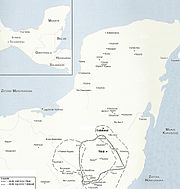| |||||
The Tikal–Calakmul wars were a series of wars, mainly between Tikal and Calakmul on the Yucatán Peninsula, but also with vassal states in the Petén Basin such as Copan, Dos Pilas, Naranjo, Sacul, Quiriguá, and briefly Yaxchilan had a role in initiating the first war.
Before the war[]
In 537 the Ajaws of Bonampak, Lakamtuun, and Calakmul were captured by Yaxchilan.[1] Bonampak and Lakamtuun remained under the control of Yaxchilan but in retaliation Calakmul conquered the latter. This gave the polity a strategic position with territory in both the east and the west of Tikal. Even though it had only about 50,000 people while Tikal had almost half a million people, Calakmul was one of the most prosperous Maya cities.[2] The entire population of the Calakmul kingdom was about 200,000.[3]
First war, 537–572[]

A building in Caracol
After conquering Yaxchilan and its subsidiaries, Calakmul allied itself with Caracol. Calakmul went on to conquer Naranjo in 546 (9.5.11.11.18 on the Maya calendar). Tikal and its kingdom were not destroyed, but suffered major losses and went into decline after the war ended in 572 (9.6.18.0.14). Mutal, the secondary city of the Tikal kingdom prospered as some of Tikal's power transferred to it.

"Cold War"[]
The phrase cold war has been used to describe the time between major conflicts involving Calakmul and Tikal. During these times there was continuous war but no major battles or political changes took place. There were of course minor border skirmishes.
Second war, 650–695[]
The second war lasted from 650 to 695 (9.10.17.3.3-9.13.2.14.19). During the second war the vassal state of Dos Pilas and its ruler B'alaj Chan K'awiil who started a civil war in Tikal and eventually sided with Calakmul played important roles.

Jasaw Chan K'awiil I
B'alaj Chan K'awiil laid claim to the royal title Ajaw and emblem of Mutal ![]() . He won a civil war with Tikal using the help of Calakmul. He betrayed the reign of Nuun Ujol Chaak and swore obedience to Calakmul, under the rule of Yuknoom The Great. From then until 695 three years after B'alaj's death Calakmul occupied Tikal. In 695 under the leadership of Jasaw Chan K'awiil I Tikal won a major battle with Calakmul and turned the tables, effectively ending the Second Tikal–Calakmul War.[4]
. He won a civil war with Tikal using the help of Calakmul. He betrayed the reign of Nuun Ujol Chaak and swore obedience to Calakmul, under the rule of Yuknoom The Great. From then until 695 three years after B'alaj's death Calakmul occupied Tikal. In 695 under the leadership of Jasaw Chan K'awiil I Tikal won a major battle with Calakmul and turned the tables, effectively ending the Second Tikal–Calakmul War.[4]
Third war, 720–744[]
K'ak' Tiliw Chan Yopaat, Ajaw of Quiriguá was one of the key people during the third war. Quiriguá was a province of Copán, then in 734 K'ak' Tiliw Chan Yopaat lead a revolution against Uaxaclajuun Ub'aah K'awiil, Ajaw of Copán. Wamaw K'awiil, kaloomte (high king, a position higher than ajaw) of Calakmul traveled to Quiriguá and formed an alliance with K'ak' Tiliw Chan Yopaat. Uaxaclajuun Ub'aah K'awiil was executed in 738, and Quiriguá became independent. By 744 El Peru and Naranjo had been reconquered by Tikal, and Calakmul had been defeated.[5]
Aftermath[]
Having been deprived of its military reputation Calakmul lost its northern provinces and collapsed, the last recorded date in the city was 899, possibly 909. Similarly Tikal, and most of the Maya cities were destroyed in the Maya collapse. The war may have contributed to the collapse, along with overpopulation, disease, famine, and others.
References[]
- ↑ Martin, Simon; Nikolai Grube (2000). Chronicle of the Maya Kings and Queens: Deciphering the Dynasties of the Ancient Maya. London and New York: Thames & Hudson. p. 121. ISBN 0-500-05103-8. OCLC 47358325.
- ↑ Braswell, G. E., Gunn, J. D., Domínguez Carrasco, M. R., Folan, W. J., Fletcher, L. A., Morales-López, A., & Glascok, M. D. (2004). "Defining the terminal classic at Calakmul, Campeche. The terminal Classic in the maya lowlands: Collapse, transition, and transformation," 162–194. Braswell et al. 2005, p.171.
- ↑ Braswell et al. 2005, p.170.
- ↑ Mesoweb.com: Second Tikal-Calakmul War
- ↑ Martin & Grube 2000, p.114.
The original article can be found at Tikal–Calakmul wars and the edit history here.
